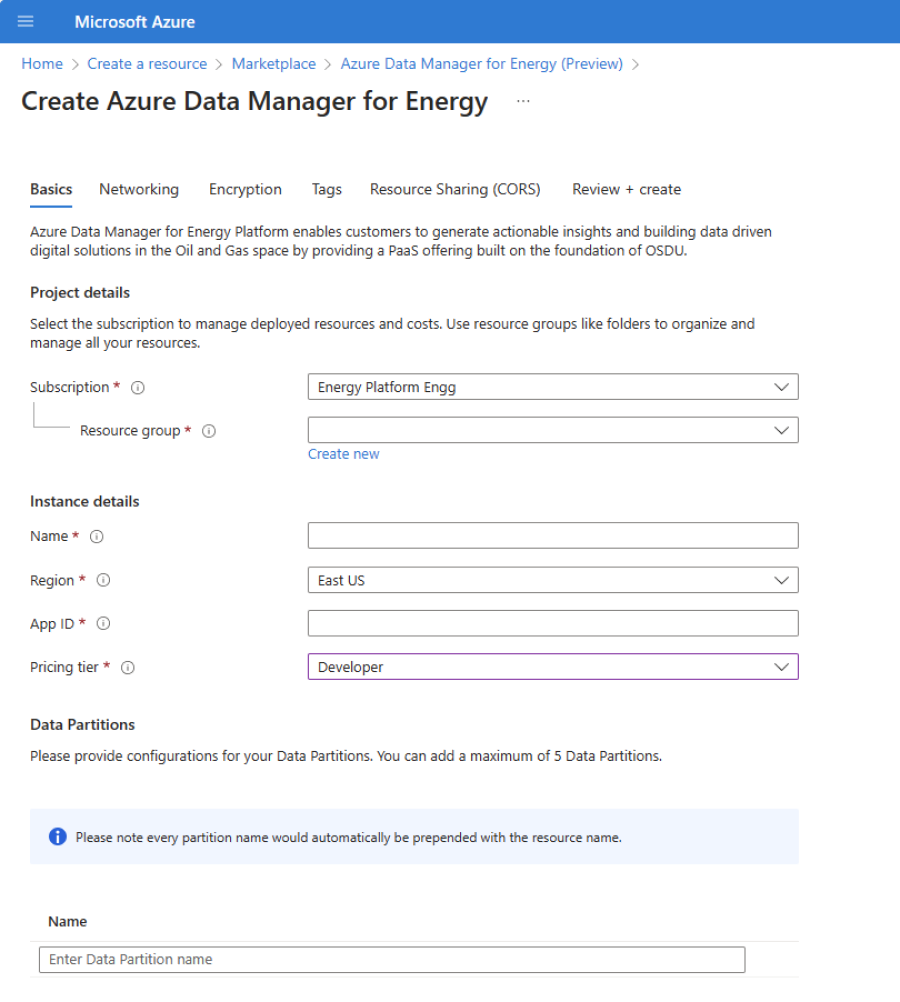
Microsoft launched Azure Data Manager for Energy, a fully managed OSDUTM Data Platform offering, to help energy companies foster and accelerate their digital innovation. Azure Data Manager for Energy helps geoscientists better find, secure, and scale the use cases of their most valuable subsurface data. Customers can now easily deploy a cluster of curated and managed resources, to meet their unique data management needs. This enterprise-grade data platform breaks down these data silos—with the power, security, and scalability of an integrated and open cloud, built in alignment with the OSDU Technical Standard that simplifies implementation and speeds time-to-market.
Since the preview release of Azure Data Manager for Energy, our customers and partners have emphasized the importance of the ability to create new applications and strategically migrate data in a cost-effective manner. Independent software vendors and energy companies at the cutting edge of innovation require a smaller configuration of Azure Data Manager for Energy that reduces the cost barriers to developing and testing new subsurface solutions on the OSDU Data Platform.
Today, we are pleased to announce the upcoming “Developer” tier for Azure Data Manager for Energy. Starting mid-June 2023, Azure Data Manager for Energy will be available in two tiers: Standard and Developer. The new tier is designed for software vendors and end users looking for more flexibility and speed in building out new applications and testing more OSDU Data Platform backed solutions. The Developer tier will provide users with the same high bar of security features, and application integration services as the Standard tier. With this tier, we aim to reduce the barriers to new innovation and enable customers and partners to select the Azure Data Manager for Energy tier that meets their business needs.
Begin your OSDU Data Platform journey with the Developer tier
Start with the Developer tier and then expand and scale to the Standard tier of Azure Data Manager for Energy. If your organization is in the evaluation stage of the OSDU Data Platform or building out a pre-production environment for testing purposes, we recommend using the Developer tier. The functionalities of the Developer tier are similar to the Standard tier at a lower cost and with reduced resource capacity. Organizations can isolate and manage their test and production environments more cost-effectively.
With the Developer tier, you can start your Azure Data Manager for Energy journey with a small number of users to mitigate cost and risk during early phases of exploration, planning, and proof of concept. In addition, the tier offers you the flexibility to evaluate and plan implementation, build demos for business use cases, as well as define your deployment pipeline. You can also validate that applications are compatible with Azure Data Manager for Energy, validate security features such as customer-managed encryption keys, or plan your broader data migration strategy. Organizations can also leverage the Developer tier for data sensitivity classification for data they want to keep strictly confidential in a separate instance. Customers can also seamlessly test a new OSDU Data Platform release, validate data ingestion scenarios, incorporate new third-party or in-house applications, validate service updates, or test API functionality—all without disrupting the production platform.
Once you move further along in your digitization journey, you can leverage the developer tier as your pre-production environment for testing and implementing large data changes or validate the impact of any service upgrade before moving to production. In addition, you can utilize the Developer tier as a secure and cost-effective way to manage access rights as you successfully execute your joint ventures, allowing you to keep your data and systems completely separated.
When to use the Standard tier
Once an organization is ready to operationalize domain workflows (such as seismic and well log) or deploy tested predictive reservoir models to a production environment on the cloud, the existing Standard tier is recommended. The Standard tier has higher database throughput and offers service level agreement, multi-region backup, and disaster recovery resources to support production workloads. The Standard tier is targeted for production scenarios that require high availability, reliability, scale, and Azure’s enterprise promises. You can leverage the Standard tier of Azure Data Manager for Energy for full-scale production use cases, such as running subsurface models or migrating seismic data across multiple applications. It supports all the use cases of the Developer tier with the addition of:
- Availability zones
- Backup and disaster recovery
- Service level agreement
- Higher database throughput
- Higher data partition maximum relative to the Developer tier
Azure support will be available for both tiers with the highest priority, response times, and severity levels provided to the Standard tier.

How to participate
Once available, you will be able to easily create a Developer tier resource by going to Azure Marketplace, create portal, and select your desired tier. Get started creating new subsurface innovations with your implementation of the OSDU Data Platform and the Azure Data Manager for Energy Developer tier by reaching out to your account team.

To learn more, visit our documentation page and read the following blogs to enable your data to do more on the cloud:
